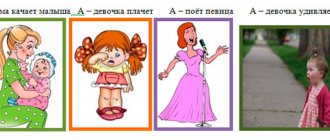Imagine a happy first-grader who already reads well and confidently writes letters in cursive, and who happily takes on his homework at home. Introduced? Does the picture look like a commercial that has nothing to do with reality?
⠀
At first glance, yes. But this is possible if you start working with your child on the development of phonemic hearing even before school. In this article we will talk about how to help a child master reading and writing through the development of phonemic awareness.
Games and exercises for the development of phonemic hearing in children 3-4 years old
"Far and Near"
The essence of the game:
⠀
You say a word loudly and say that this word sounds loud because I am next to you. Then move away and say another word, only more quietly. Ask your child to repeat the word and tell him that it sounds quiet because you are standing far away.
⠀
Then you alternately name the words, either quietly or loudly, and the child must say which words sound “far” and which “close.”
⠀
This game teaches your child to recognize and remember sounds in words.
"Right wrong"
You will need picture cards. Suitable pictures for development 0+, where various objects, plants and animals are drawn.
⠀
The essence of the game:
⠀
Take a card with any picture and ask your child to clap if you incorrectly name the object in the picture. For example, let there be a card with an apple. You show it to the child and say: “MAP.” The child claps and you ask him to name the word correctly. You can also intentionally miss a sound in a word and the child must correct you.
⠀
Thanks to this exercise, the child remembers the correct sound of words, which will help him make fewer mistakes when learning to read.
"Extra syllable"
The essence of the game:
⠀
You monotonously repeat the same syllable to the child, and then add another syllable to this identical series. At this moment, the child should stop you with a clap and name the extra syllable. For example, you say: “GA-GA-GA-GA”, and then insert “YES” and continue to “gag” further. The child hears a different sound, claps his hands and names the extra syllable.
⠀
This game develops hearing well, trains attention and teaches you to distinguish sounds.
How to develop phonemic hearing in children with ODD. Consultations for parents.
GBDOU d/s No. 15 of a compensating type in the Petrogradsky district of St. Petersburg. Speech therapist teacher: Kuzmenko L.N.
Phonemic hearing is a person’s ability to analyze and synthesize speech sounds, i.e. hearing, which provides the perception of phonemes of a given language. "Speech therapist's dictionary" ed. IN AND. Seliverstova.
Most parents believe that it is enough to teach their child the letters, and he will begin to read and write correctly. But this is a big misconception!
Practice shows that knowledge of letters does not exclude serious difficulties for schoolchildren when learning to read and write. How much the child worries about the mistakes corrected by the teacher’s red pen! How boring it is to do “Work on mistakes”!
The main cause of errors is impaired phonemic hearing, i.e. ability to distinguish and isolate speech sounds. In order to write correctly, the child needs to imagine that a sentence consists of words, words of sounds, and the sounds in a word are located in a certain sequence. Therefore, it is important to develop phonemic hearing in a child!
Let's get started! Classes should not be boring lessons, but an interesting game. After all, play, being the leading activity of preschool age, allows you to make the learning process accessible and interesting. Our classes will be held in a playful form, but will be educational in nature. In essence, they are “Working on errors”, preventing their occurrence. This kind of “Work on mistakes” is fun to do, and when you come to school, your child will write a dictation without mistakes.
Scientists have proven that even before birth, children hear and react to sounds from the outside world in different ways.
With the birth of a child, these sounds fill his world: the singing of birds and the murmur of water, the sound of the wind and the rustling of leaves. The baby begins to listen to surrounding sounds. But words—speech sounds—are the most significant from his birth. Sounded speech provides the necessary communication and information acquisition for the child.
By listening to words, comparing their sounds and trying to repeat them, the child begins not only to hear, but also to distinguish the sounds of his native language. This ability develops in him gradually. From 2-4 weeks from birth, the baby begins to respond to any sounds. Melodious sounds make him feel satisfied and smile, and sharp sounds (angry voice) make him cry. At 7-10 months the child already responds to the word. Only towards the end of the first year of life does the word first begin to serve as an instrument of communication.
Further, phonemic development occurs rapidly, constantly ahead of the child’s pronunciation capabilities. Already in the third year of life, children can notice incorrect pronunciation among their peers and even try to correct them.
And by the age of 5, a child develops a critical attitude not only to someone else’s speech, but also to his own speech. He is very sensitive to the inaccuracies of his pronunciation, which manifests itself in his refusal to communicate and to collaborate together. In addition, this necessarily affects the mastery of reading and writing.
Correcting pronunciation deficiencies in children involves producing sounds and introducing them into speech while simultaneously developing phonemic hearing. Without a full perception of sounds, without their clear distinction, the formation of pure speech is impossible.
But, if a child pronounces all the sounds correctly, he often does not distinguish some of them by ear, and this, in turn, greatly complicates and sometimes distorts the understanding of speech, and also manifests itself in errors when writing.
It is much easier to prevent a violation than to correct it. This means that work on developing phonemic awareness prepares children to master correct pronunciation and is aimed at preventing grammatical errors.
First of all, find out how the baby perceives and distinguishes sounds. The following simple tasks will help with this: 1. Offer to repeat after you the syllables: sa-sha, sha-sa, sa-tsa, ach-ashch, ra-la, sha-zha. If a child pronounces some sounds incorrectly, discrimination is checked as follows: ask him to perform some action after hearing a given syllable. For example, if among the syllables sa, tsa, cha, the syllable sha is called, the child claps his hands. 2. Let’s check whether the child distinguishes words that are similar in sound but different in meaning.
- Invite him to choose the desired picture among: beetle-bitch, house-catfish, bowl-mouse, goat-braid, puddle-ski.
- Explain the meaning of the words: “What is a puddle and what is a ski?”
3. The following technique will reveal the degree of development of attention and auditory memory.
- Invite your child to repeat similar syllables: ta-da-ta, ka-ga-ga, pa-ba-ba, ma-na-ma.
- Repeat similar words: Masha-Dasha-porridge; shadow-day; day-stump; lac-mac-crayfish; beetle-bow suk-knock.
Difficulties in completing tasks indicate a decrease in phonemic awareness.
Work on the development of phonemic perception begins with the material of non-speech sounds and, gradually, covers all speech sounds. The tasks are offered in strict sequence, conditionally divided into six stages:
- recognition of non-speech sounds;
- distinguishing the height, strength, timbre of the voice, based on the same sounds, combinations of words and phrases;
- distinguishing words that are similar in sound composition;
- syllable discrimination;
- distinguishing sounds;
- analysis of the sound composition of a word.
Let's get started on developing your baby's phonemic awareness!
Stage 1 – recognition of non-speech sounds.
The goal of the first stage is the development of auditory attention and auditory memory, which is especially important for the successful development of phonemic perception in general. The inability to listen attentively to the speech of others is often one of the reasons for incorrect pronunciation, so it is necessary to teach the child to hear sounds and be able to compare them.
Let's look at what games and exercises can be done with children at the first stage of work.
- Invite your child to listen to the sounds outside the window: “Close your eyes and listen!” What's making noise? What's buzzing? Who's screaming? Who's laughing?"
- Use the following games:
Game "Sun or Rain?"
Today we will go for a walk. There is no rain. The weather is good, the sun is shining, and you can pick flowers. You go for a walk, and I will ring the tambourine. Let's have fun walking to these sounds. If it starts to rain, I'll start banging on the tambourine. And when you hear the knock, you should run under your umbrella. Listen carefully!
The game “Sun and Rain” is quite simple, however, children really like it and it’s always fun!
Game "Big or Small".
Place two toy hares (bears, dolls) on the table - a large one and a small one. Explain and show how the big hare, who has a lot of strength, plays the drum loudly, and the little one plays quietly. Then cover the toys with a screen and behind it make loud and then quiet beats on the drum. The kid must find out and show which of the hares just played.
Such games should be played with children starting from 2-3 years old. But, even if the kids are older, and you have discovered a decrease in phonemic hearing, you should also start working with these games. Because only gradually increasing the complexity of tasks will achieve maximum efficiency.
Stage 2 – distinguishing the height, strength, timbre of the voice.
At this stage, it is necessary to teach the child to understand the intonation of speech and to master the means by which the emotional shades of speech are expressed.
Game "Far - Close".
The game is aimed at developing the basic qualities of the voice: strength, height.
An adult shows the child a toy kitten and asks him to listen carefully and remember how it meows when it is close (loud), and how it meows when it is far away (quiet).
Then he says “Meow”, changing the strength of his voice, and the baby guesses whether the kitten is meowing close or far away.
Then the baby himself meows at the adult’s signal: “far” - “close”.
A further complication of the game is that the child will distinguish between meows, focusing on the timbre and individual characteristics of the speaker’s voice. The adult explains that the kitten is very afraid of the puppy and meows pitifully, trembling with fear. The child should meow, feigning fear.
Similarly, you can play by distinguishing where the steamer is humming (oooh) - far away (quietly) or close (loudly); what kind of pipe is playing - a large one (“oo-oo-oo” pronounced in a low voice) or a small one (“oo-oo-oo” pronounced in a high voice); who is crying - a boy (“a-a-a” in a low voice) or a girl (“a-a-a” in a high voice).
In addition, at this stage it is important to teach the child to determine the tempo of speech by ear. Games for performing movements at an appropriate pace will help with this.
Game "Guess what to do."
An adult pronounces the phrase: “The mill grinds grain” several times at different tempos. Children, imitating the operation of a mill, should make circular movements with their hands at the same pace at which the adult speaks. You can also play on other phrases: (“Our feet walked along the road”) or even poetry:
A drop once, a drop two, A drop slowly at first - Drip, drip, drip, drip. (slow clapping) The drops began to keep up. Drop drop catch up - Drip, drip, drip, drip (pop more often). Let’s quickly open the umbrella and protect ourselves from the rain (hands above our heads).
Use dramatization.
An adult tells the fairy tale “The Three Bears”, accompanying his speech with illustrations. Pronouncing remarks either very low, then medium in pitch, then in a high voice he asks: “Who is saying this?” The kid guesses the bears.
Ask, for example: “What did Bear say when he saw his chair moved?”
The baby, answering questions, changes the pitch of his voice accordingly. An adult must ensure that, imitating Mishutka, Ursa and the Bear, the child does not speak very high (to the point of squeaking) and very low (to the point of hoarseness in his voice), i.e. to raise and lower his voice within the limits available to him.
You can dramatize this tale with older children.
When playing with a 2-4 year old child, the adult directs the course of the game, taking on the role of the leader. Children 5-7 years old, having learned the rules of the game, can play independently.
Stage 3 – distinguishing words that are similar in syllabic composition.
A child’s mastery of speech is associated with his increased interest in the sound of the word. By the end of the second year of life, the baby becomes a real inventor, composing entire songs consisting of a set of different sounds and words that are similar in sound. He listens to their combination, enjoying the sound. Thus, the child carries out a lot of mental work on the sound side of the word.
Let's take advantage of each child's natural talent for rhyming words.
Game "Don't make a mistake."
An adult shows a picture and loudly and clearly calls the image: “Paper.” Then he explains: “I will name this picture either correctly or incorrectly, and you listen carefully. When I make a mistake, clap your hands." Then he says: “Paper - pumaga - tumaga - pumaka - paper.” The game is interesting to children and they always respond happily to it.
It must be emphasized that you need to start with simple words and sound composition, gradually moving on to more complex ones.
You can use poems to include the missing word, which develops a sense of rhythm and rhyme in children, helps expand their vocabulary, and improves the child’s phonemic awareness.
— In Africa we will find coconut and (pineapple) more than once. — Brooches and hairpins are arguing: who has the sharper ones (needles).
Stage 4 – distinguishing syllables.
A syllable is the minimal unit of speech flow. For games on distinguishing syllables, it is good to use onomatopoeia.
The game “Who is screaming?” An adult puts up pictures and says: “Look at the pictures, listen to who screams and repeat.”
- Another version of the game: pictures for the child. The adult names the syllables, and the baby picks up the corresponding picture.
Stage 5 – distinguishing sounds
In any language there is a certain number of sounds that create the sound appearance of a word. Sound outside speech has no meaning; it acquires it only in the structure of the word, helping to distinguish one word from another (dom, som, com). This sound is called a phoneme (hence “phonemic hearing”). Everyone remembers such characteristics as consonant and vowel sounds. You need to start by distinguishing vowel sounds.
— An adult gives pictures to the child Pictures of a train, a girl, a bird and explains: “The train is buzzing oo-oo-oo; the girl is crying ah-ah-ah; the bird sings and-and-and-and.” Next, he pronounces each sound for a long time, and the child picks up the corresponding picture.
Work on distinguishing consonant sounds is carried out in a similar way.
Game "Bike Ride".
— The adult says: “Now we’re going to go riding bicycles. Let's check if the tires are well inflated. Let's pump it up again: sssss... (Children imitate). Hear the air hissing: shhhh..." - Be careful, if I show a picture of a pump, you should say: “ssss,” and if with a picture of a tire: “shhhh.”
The game “Bug and Mosquito” is played in a similar way (sounds C and F).
Stage 6 – analysis of the sound composition of the word.
The term “phonemic (sound) analysis” defines both elementary and complex forms of sound analysis. Elementary is the selection of sound against the background of a word. Isolating the first and last sound from a word and determining its place (beginning, middle or end of the word) refers to a complex form. The most difficult sound analysis is determining the sequence of sounds in a word. Complex forms arise only during the learning process, and even then, only after the child has mastered the skills of elementary analysis of the sound composition of a word.
- Children hear and identify the stressed vowel at the beginning of a word best: Name the first sound in the word Beehive, Stork, Ira, Olya.
- Give the child several identical circles. An adult pronounces one, two, three vowel sounds: a, ay, aui. The child places as many circles on the table as the sounds the adult makes.
Game “We’ll let a set of special words into the yard.”
The adult invites the children to depict a closed gate: palms turned towards the face, connect the middle fingers, raise the thumbs up: “We will “let through” only words with a given sound into the yard.” Kids open the gate if they hear a given sound. If the word does not contain the specified sound, then the gate slams. At the end, you can invite the children to remember all the words that they “missed into the yard.”
Let's start analyzing consonant sounds. In this case, the sequence must be observed: first, they are taught to highlight the last consonant sound in a word.
Select the pictures so that the word ends with a consonant sound and put it in an envelope. The child takes out the pictures one at a time, names them loudly, highlighting the last sound. Then the baby names the sound separately (beetle, onion, cat).
Game “Don’t touch the ball or catch it – try to guess”
The adult invites the child to catch the ball if he hears a given sound at the end of a word, or to hide his hands behind his back if there is no given sound.
Only after the baby learns to easily perform such tasks can one move on to complex forms of sound analysis: this is determining the place of a sound in a word (beginning, middle, end), determining the sequence of sounds in a word, their number.
The experience your children will gain will make their schooling much easier. And you didn’t have to set up some kind of school at home. We played! And in the game, even the complex becomes accessible. The most important thing is to believe in your child and help him understand the world of sounds!
Used literature: Kunichenko O.A. “Development of phonemic hearing”, Tkachenko T.A. “Development of phonemic perception and sound analysis skills”, Boryakova N.Yu., Kositsina M.A. “Correctional and pedagogical work in kindergarten for children with special needs development.” Program for the education and training of preschool children with mental retardation, ed. Boryaeva L.B. and Loginova E.A.
Games for children 4–5 years old
"Sound Lost"
The essence of the game:
⠀
Make a sound with your child that he will look for in words. Let him choose which one he likes best. Let's say "M". Then start saying different words with and without this sound. The child should stamp his foot or clap when he hears a word with the sound “M”: DRUM, FLOWER, APPLE TREE, BANANA, STORE, OWL, MOTOR.
⠀
This exercise also trains attention, hearing and correct perception of sounds.
"Lost Word"
The essence of the game:
⠀
This game is similar to the previous one. Only here you need to look not for a sound, but for a word that is lost among words that sound similar. Make a word with your child, for example “POT”. Then say consonant words: DAUGHTER, CAR, LOBE, HUMM, KIDNEY, POINT, BARREL. When a child hears a lost word, they should respond by clapping or jumping.
"You are my echo"
⠀
The essence of the game:
⠀
Invite your child to play echo. Say: “You will be my echo. I will speak, and you repeat after me.” Then go to another room and start the game. Choose words and sounds that your child pronounces with errors or difficulty. By repeating after you several times, your child will hone the correct pronunciation.
Correction
Phonemic hearing impairment in children is treated comprehensively. What to drink or how to exercise, you need to find out from specialists: a neurologist, psychiatrist, speech therapist, speech pathologist. Medical care is provided along with active classes with teachers.
Drug treatment
You cannot teach speech with the help of medications, but their use helps improve the functional state of the brain and blood flow. An increase in brain performance is directly related to an increase in memory capacity and the ability to concentrate. Kids have to work hard, try to remember new things, and monitor their own and other people’s speech. Pills and injections help him in this difficult process.
Most often, a neurologist and speech therapist prescribe:
- Pantogam
Stimulates the central nervous system, reduces excitability, increases mental performance.
- Glycine
Relieves emotional stress, aggression, improves sleep.
- Phenibut
Normalizes metabolism in tissues and blood circulation in the brain. Relieves feelings of fear, anxiety, increases performance.
- Cortexin
Restores brain function after injury and stress. Improves memory, attention, increases the level of learning.
Simultaneously with taking medications, massage and exercise therapy are prescribed. Parents should also monitor the baby’s nutrition. Add more meat dishes and fruits to your diet. Pay attention to the hemoglobin level.
Games for children 5–6 years old
"Singing Lotto"
This game must have a leader and at least two participants. It is designed for children who already fully or partially know the alphabet.
The essence of the game:
⠀
Take picture cards and blank cards. Give the children 5-7 cards with pictures and the same number of blank ones. Then sing any sound and ask who has pictures of an object containing that sound. Children find a suitable card, say the word and cover the image with a blank card. The winner is the one who closes all the pictures the fastest.
⠀
For example, you start: “Uuuuuuuu” and ask who has an image with that sound. The child raises his hand and says: “Uuuuu-tka” and covers the picture with a blank card.
⠀
This exercise helps children quickly master reading syllables.
“Complete the missing syllable or word”
Simple sentences from your child’s favorite fairy tales are suitable for this exercise.
⠀
The essence of the game:
⠀
You read the sentence to your child, but do not say the last syllable or word. The child must complete the word and speak the entire sentence.
⠀
How it manifests itself
Mixing sounds and substitutions provoke dyslalia. Its presence can be determined by the following signs:
- Violation of sound pronunciation. Substitution of sound, for example, voiced sounds are perceived and pronounced as voiceless, hard sounds as soft.
- Omitting consonants and vowel phonemes in words, rearranging them, adding extra sounds. For example, sLobodny, instead of svobodny, dereLa instead of tree, etc.
- Weak differentiation of similar phonemes, their replacement in oral and written speech. For example, mixing and replacing s, z, w - rat instead of roof, bough instead of beetle.
Impaired phonemic hearing in children leads to errors in grammar. The most common spelling errors are unstressed vowels, double consonants, and unvoiced words at the end of a word. The student simply does not hear the impact sound. For him it is similar to an unstressed word, so it is difficult for him to select a test word. At school, such children fail not because of mental retardation or poorly developed intelligence, but because of impaired phonemic hearing.
First stage
The initial stage of work allows you to create a base, a foundation for the development of fine hearing and is suitable for very young children. What do we have to do? Play! For example, the game “Guess what it sounds like.” Everyday situations can be played out: the sound of pouring water, the clinking of dishes, a person’s steps, a cat’s meowing, the rustling of paper.
Other exercises for this stage:
• “Magic sounds”. Together with your child, fill woven bags, opaque plastic containers, or just matchboxes with any “sounding” materials: cereal, metal clips, buttons. You need to guess by the sound what's inside.
• Regular “Zhmurki” is perfect for solving phonemic problems. The child needs to move towards an agreed sound, for example, clapping hands or ringing a bell.
• "Magic Pencil". Give your child a regular pencil and ask him to tap objects of different textures made of wood, glass, metal, and paper.
• “Clap!” The child needs to repeat after the adult the rhythm of clapping and alternating pauses of different lengths. First, the exercise is done with open eyes, then you can make it more difficult: blindfold your eyes with a scarf or simply close them.
To understand how to practice, watch informational videos about the development of phonemic hearing. The video will help you not only understand the logic of the lesson, but also master the most effective working techniques.
How common is the combination of hearing loss and autism?
In practice, there are cases when a child suffers from mental illness and hearing loss, but such cases are very few. Usually, if a child resists examination, then his hearing may be quite normal, but this does not negate the importance of the hearing test procedure.
We can give several striking examples that clearly show the connection between delayed psycho-speech development and hearing impairment. One of the cases when a 6-year-old boy with mental retardation was not examined for hearing impairment, and his parents could not find the cause of the pathology. As it turned out, he suffered from sensorineural hearing loss of the 3rd degree, although he answered the doctor’s questions, but it was an indistinct muttering. The parents were initially treating the wrong disease, but they should have started with a hearing test.
According to the observations of specialists, children with normal development usually contact a doctor and undergo a hearing test. Small patients who suffer from varying degrees of hearing loss allow manipulation, they find it interesting. This applies to children over one year of age.
The conclusion is one indisputable fact: if parents observe a delay in psycho-speech development in a child, they should start as early as possible with a hearing test in such a child, and only then go to neurologists and psychiatrists.
The article is for informational purposes only, self-medication is not acceptable. Be sure to consult with your healthcare provider.
Why develop phonemic awareness?
The formation of speech skills begins from the first minutes of a newborn’s life - with his screaming, humming, and babbling. But the baby consciously pronounces his first words towards the end of the first year of life. During the second year, the ability to pronounce words improves, but pronunciation remains unclear and imprecise. By the end of the third year of life, it is already possible to trace the first signs of imperfect phonemic hearing:
• it is difficult for a child to pronounce words consisting of more than two syllables (a syllable is a combination of a consonant and a vowel);
• the child skips syllables in words and replaces sounds.
If the environment is favorable, the child hears correct speech, communicates a lot, then by the age of four the situation improves. Long words of several syllables and hissing sounds appear in one’s own speech, but there are problems with the complex sounds R-L-Y. This is where you need to work to avoid making mispronunciation the norm. At the age of five, a preschooler must learn to pronounce all sounds correctly without exception, hear the syllabic structure of a word and accurately reproduce it.
What happens if the child himself cannot cope with the language load, and there is no timely assistance in the development of phonemic hearing? A persistent speech disorder will appear due to incorrect perception and pronunciation of words. Violation of pronunciation norms is a serious defect, which in speech therapy practice is called phonetic-phonemic underdevelopment of speech and automatically makes a primary school student a potential D student, or at most a C student, in the Russian language.
Without being able to distinguish between individual sounds and syllables, a student will not learn to analyze a word, divide it into syllables and morphemes (parts), and see the spelling - that is, a dangerous place in which one can spell it wrong. It will be impossible to even write down the word correctly, that is, a persistent violation of the rules of graphics will form.
Problems cannot be avoided in live, spoken speech. The active vocabulary will remain poor, and understanding of the grammar of the native language will be impaired. The child will not be able to read correctly, create his own statement, intonate individual sentences and the text as a whole; it will be difficult for him to regulate the pace and volume of speech, and pronounce complex words correctly. This means that psychological discomfort will inevitably arise, which will affect behavior.
Is it necessary to develop phonemic awareness? The answer to this question is obvious. Moreover, you need to start not on the eve of entering first grade, but much earlier. It is better to start classes at the age of three, and then constantly devote as much time as possible to speech practice.
Forecast and preventive measures
If a child is confused about sounds, it is important to contact a speech therapist in a timely manner. With regular classes and the help of parents, speech underdevelopment can be eliminated within a year. Depending on the severity of FFN, the work takes from 1 to 12 months.
Parents have a strong influence on the development of oral language skills. Very often, problems with pronunciation of sounds arise due to pedagogical neglect. Therefore, it is recommended to work with the baby from the moment of his birth. Mothers who have experienced difficult childbirth and pregnancy should be especially careful. It is important to visit specialists in a timely manner and not let the situation take its course.
Second phase
At the next level, you need to show the child the difference in the quality of human speech.
• “Who is speaking?” Record on a voice recorder the voices of adults familiar to the child (mother, grandmother, father, brother or sister) and, of course, the voice of the baby himself. The path guesses who the voice belongs to.
• "Three Bears". This is a simulation exercise. Read the story of the three bears together and then speak for the characters. The child should guess when mommy bear, daddy bear and cub speak.
• “Loud or quiet?” Think of actions that the child should perform when his mother’s voice is quiet and when his voice is loud.











